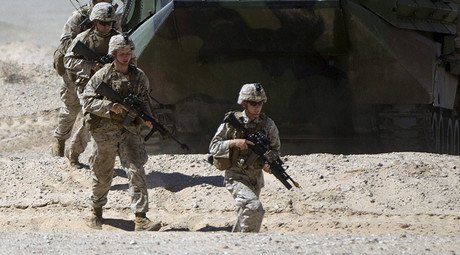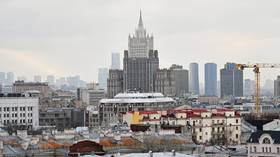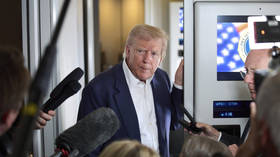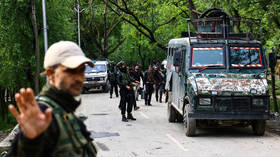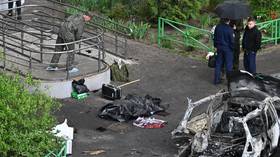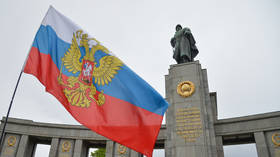US Special Forces deployed as ‘human shields’ to salvage terror assets in Syria
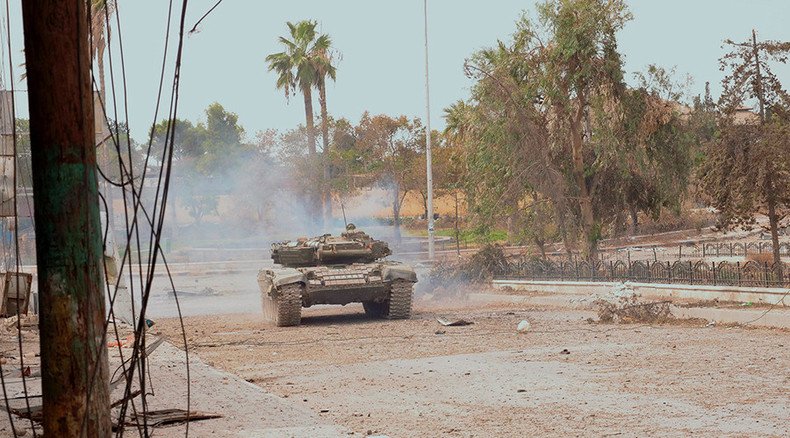
Obama’s decision to send Special Forces into Syria is being widely viewed as a US military escalation in the country. The troop dispatch also signals that the US trying to forestall Russian successes in wiping out Washington’s regime-change assets in Syria.
In short, the US Special Forces are being used as “human shields” to curb Russian air strikes against anti-government mercenaries, many of whom are instrumental in Washington’s regime-change objective in Syria.
First of all, we need to view a host of developments, including the hastily convened “peace talks” in Vienna, as a response by the US and its allies to the game-changing military intervention by Russia. That intervention, beginning on September 30, has not only dealt massive blows to militants, it has completely changed the balance of forces to give the Assad government the upper hand in the war against foreign-backed extremists. That, in turn, has sent the US-led powers trying to topple Damascus into disarray.
Recall the scattered reactions from Washington and its allies, including Britain, France, Turkey, Saudi Arabia and Qatar. At first, Washington tried to rubbish Vladimir Putin’s order to aid his Syrian ally with airstrikes as “doomed to fail”.
Then there were overblown, unverified, claims of civilian casualties from Russian strikes, plus there were American claims that Russian cruise missiles had gone wildly astray, hitting Iran. There was also much angst over Russia striking “moderate rebels” instead of the Islamic State terror network. All such accusations, encouraged with Western media amplification, were designed to undermine Russia’s military operation.
Then there were threats from Saudi Arabia and Qatar that they would launch direct military action in Syria to “protect” the populace from the joint firepower of Assad and Putin. That idea was quickly shelved (one wonders by whom?).
Another seeming knee-jerk response came from Turkey and rightwing politicians and pundits in the US which revived talks about the creation of “safe havens” in northern Syria, ostensibly to protect civilian refugees, but also tacitly and more importantly, to give cover to “rebel” groups from Russian air strikes and Syrian government ground troops.
None of these reactions have gained credibility despite Western media hype. On the contrary, it soon became clear that Russia’s military intervention in Syria was a masterstroke by Putin, wiping out large swathes of the anti-government mercenaries, stabilizing the Assad government, and winning much popular support both within Syria and across the Middle East, and indeed around the world.
Last week, America’s top military official, General Joseph F Dunford, Chairman of the Joint Chiefs of Staff, told a Senate committee that Russia’s air support had changed everything. “The balance of forces right now are in Assad's advantage,” he said.
This is the context in which to interpret the latest, surprise move by Obama to send Special Forces into Syria. It is more about inhibiting Russian success in destroying the sundry anti-regime forces on the ground than about either “helping the fight against Islamic State” as claimed, or about misgivings of a large-scale American invasion.
The troop contingent that Obama has ordered amounts to 50 Special Forces personnel. That is hardly going to be a decisive blow to Islamic State militants, even if we believe the official rationale for their deployment.
The White House, in its announcement, was at pains to emphasize that the troops would not be in a combat role and would only be acting to “advise and train” Kurdish fighters and others belonging to the little-known Syrian Arab Coalition.
But here is perhaps the significant part of the story. “The move could potentially put the American troops in the cross hairs of Russia,” reports the New York Times. Significantly, too, the Pentagon will not be informing the Russian military of the exact whereabouts of its ground personnel.
That suggests that the real purpose for Obama sending in the troops is to restrict Russian offensive operations by introducing the risk of bombing American forces. In effect, the US Special Forces are being used as human shields to protect American regime-change assets on the ground.
These assets include an array of jihadist mercenary brigades, which the US and its allies have invested billions of dollars in for the objective of regime change in Syria. The misnomer of “moderate rebels” belies abundant evidence that the mercenaries include Al Qaeda-linked terror groups, including Islamic State. CIA supplies of anti-tank TOW missiles as well as Toyota jeeps are just a glimpse of the foreign covert-sponsorship.
Russia’s devastating air campaign over the past month – over 1,600 targets destroyed according to Moscow – has no doubt caused apoplexy in Washington, London, Paris, Ankara, Riyadh and Doha. An urgent stop to their “losses” had to be invoked. But the foreign sponsors can’t say it openly otherwise that gives the game away about their criminal involvement in Syria’s war.
Combat report: Over 1,600 terror targets destroyed in 1 month of Russia's #Syria op - MoD https://t.co/W7KcFPh4nrpic.twitter.com/tA1Uwj1nfN
— RT (@RT_com) October 30, 2015This perspective most likely explains the hastily convened “peace conference” in Vienna. US Secretary of State John Kerry’s apparent concern to “stop the bloodshed” does not seem credible as the primary motive. Why the concern now after nearly five years of bloodshed?
It is not about a “quest for peace” as the BBC reported. The move is more credibly about Washington and its allies maneuvering to give their regime-change assets in Syria a reprieve from Russia’s firepower. One of the main points agreed in Vienna this weekend is the implementation of a “nation-wide ceasefire”.
Another indicator of what is really going on are reports this week of the large-scale airlifting of jihadist mercenary groups out of Syria. According to senior Syrian army intelligence, up to 500 mercenaries were flown to Yemen onboard Turkish, Qatari and Emirati planes. The fighters were brought to Yemen’s southern city of Aden from where they were dispatched to battle zones inside Yemen by the American-coordinated Saudi coalition. The US-Saudi coalition is waging war in Yemen to reinstall the regime of exiled President Abed Rabbo Mansour Hadi ousted by Houthi rebels earlier this year.
Aden is under the military control of Saudi and Emirati forces and Yemen’s airspace has been closed off by the coalition coordinated by US and British military planners based in Saudi capital Riyadh. It is inconceivable that plane loads of jihadists could be flown into southern Yemen without the knowledge of Washington.
So what we are seeing here is a concerted effort by Washington and its allies to stem their covert military losses in Syria. Sending in American Special Forces – a seemingly dramatic U-turn by Obama to put boots on the ground in Syria – is just one part of a wider effort to forestall Russian success in stabilizing Syria. These US forces are not about a “deepening of American involvement in a war [Obama] has tried to avoid”, as the New York Times would have us believe. They are being sent in to act as human shields against Russian airstrikes.
The putative ceasefire under a so-called peace process is another element of the US-led salvage operation. The real agenda is about giving Western, Turk and Arab-sponsored jihadists a space to regroup, and if needs be flown out of the Syrian theatre to resume their imperialist function in Yemen and, no doubt, elsewhere when required.
The statements, views and opinions expressed in this column are solely those of the author and do not necessarily represent those of RT.

